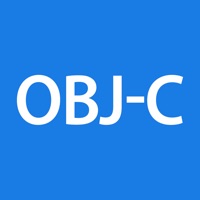
ダウンロード Obj-C Programming Language
投稿者 Dmitry Kovba
- カテゴリ: Reference
- 現在のバージョン: 13.0
- ファイルサイズ: 833.00 kB
- 互換性: iOSが必要です Windows 11, Windows 10/8/7/Vista

投稿者 Dmitry Kovba
APK -PC用 - ダウンロード
| ダウンロード | 開発者 | 評価 | ファイルサイズ (MB) |
|---|---|---|---|
| ダウンロード Apk | Intelitech | 0 | 3.9M |
OK。 最初のものが最初に。 お使いのコンピュータでアプリケーションを使用するには、まずMacストアまたはWindows AppStoreにアクセスし、Bluestacksアプリまたは Nox App Web上のチュートリアルのほとんどはBluestacksアプリを推奨しています。あなたのコンピュータでBluestacksアプリケーションの使用に問題がある場合は、簡単にソリューションをオンラインで見つける可能性が高くなるため、推奨するように誘惑されるかもしれません。 Bluestacks PcまたはMacソフトウェアは、 ここ でダウンロードできます。.
あなたが選択したエミュレータをダウンロードしたので、コンピュータのダウンロードフォルダに移動して、エミュレータまたはBluestacksアプリケーションを探します。
見つかったら、クリックしてアプリケーションまたはexeをPCまたはMacコンピュータにインストールします。
[次へ]をクリックして、ライセンス契約に同意します。
アプリケーションを正しくインストールするには、画面の指示に従ってください。
上記を正しく行うと、エミュレータアプリケーションが正常にインストールされます。
これで、インストールしたエミュレータアプリケーションを開き、検索バーを探します。 一度それを見つけたら、 Obj-C Programming Language を検索バーに入力し、[検索]を押します。 クリック Obj-C Programming Languageアプリケーションアイコン。 のウィンドウ。 Obj-C Programming Language - Playストアまたはアプリストアのエミュレータアプリケーションにストアが表示されます。 Installボタンを押して、iPhoneまたはAndroidデバイスのように、アプリケーションのダウンロードが開始されます。 今私達はすべて終わった。
「すべてのアプリ」というアイコンが表示されます。
をクリックすると、インストールされているすべてのアプリケーションを含むページが表示されます。
あなたは アイコン。 それをクリックし、アプリケーションの使用を開始します。
こんにちは。 Macユーザー!
使用する手順 Obj-C Programming Language - Macの場合は、上記のWindows OSのものとまったく同じです。 Nox Application Emulator をインストールするだけです。 あなたのMacintosh上のBluestack。 ここ で入手できます。
Obj-C Programming Language iTunes上で
| ダウンロード | 開発者 | 評価 | スコア | 現在のバージョン | アダルトランキング |
|---|---|---|---|---|---|
| 無料 iTunes上で | Dmitry Kovba | 11 | 3.5 | 13.0 | 17+ |
The classic Objective-C programming language for iPad, iPhone and iPod touch. Programming language is a perfect tool for studying, complex mathematical calculation, entertainment and many other useful tasks. The application is especially useful for learning the Objective-C programming language. You have to buy compilations inside the application. Internet connection is required. - The great programming tool on the AppStore. - Your programming language for iOS is amazing! * FEATURES * - Compile and run your program. - Text input before program run and text output. - Import and export programs by iTunes or by email. - Online language reference and several program samples. * LIMITATIONS * - Internet connection is required to compile and run a program. - Graphics, network, file system and real-time input are not supported. - Maximum running time of a program is 15 seconds. - iOS interface controls are not supported. Thanks for using the application! ==================================== Objective-C is a reflective, object-oriented programming language that adds Smalltalk-style messaging to the C programming language. Today, it is used primarily on Apple's Mac OS X and iOS: two environments derived from the OpenStep standard, though not compliant with it. Objective-C is the primary language used for Apple's Cocoa API, and it was originally the main language on NeXT's NeXTSTEP operating system. Generic Objective-C programs that do not use these libraries can also be compiled for any system supported by gcc or Clang. Objective-C was created primarily by Brad Cox and Tom Love in the early 1980s at their company Stepstone. Both had been introduced to Smalltalk while at ITT Corporation's Programming Technology Center in 1981. The earliest work on Objective-C traces back to around that time. Cox was intrigued by problems of true reusability in software design and programming. He realized that a language like Smalltalk would be invaluable in building development environments for system developers at ITT. However, he and Tom Love also recognized that backward compatibility with C was critically important in ITT's telecom engineering milieu. Cox began writing a pre-processor for C to add some of the capabilities of Smalltalk. He soon had a working implementation of an object-oriented extension to the C language, which he called "OOPC" for Object-Oriented Pre-Compiler. Love was hired by Schlumberger Research in 1982 and had the opportunity to acquire the first commercial copy of Smalltalk-80, which further influenced the development of their brainchild. In order to demonstrate that real progress could be made, Cox showed that making interchangeable software components really needed only a few practical changes to existing tools. Specifically, they needed to support objects in a flexible manner, come supplied with a usable set of libraries, and allow for the code (and any resources needed by the code) to be bundled into a single cross-platform format. Love and Cox eventually formed a new venture, Productivity Products International (PPI), to commercialize their product, which coupled an Objective-C compiler with class libraries. In 1986, Cox published the main description of Objective-C in its original form in the book Object-Oriented Programming, An Evolutionary Approach. Although he was careful to point out that there is more to the problem of reusability than just the language, Objective-C often found itself compared feature for feature with other languages.